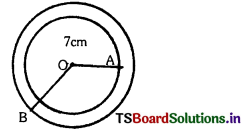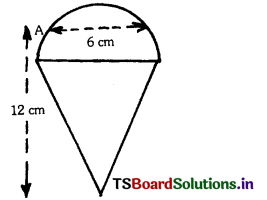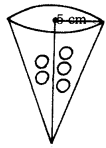Students can practice 10th Class Maths Study Material Telangana Chapter 10 Mensuration Ex 10.4 to get the best methods of solving problems.
TS 10th Class Maths Solutions Chapter 10 Mensuration Exercise 10.4
Question 1.
A metallic sphere of radius 4.2 cm is melted and recast into the shape of a cylinder of radius 6 cm. Find the height of cylinder. (AS4)
Solution:
Radius of the sphere(r) = 4.2 cm
Volume of the sphere = \(\frac{4}{3}\) πr3
= \(\frac{4}{3}\) × \(\frac{22}{7}\) × 4.2 × 4.2 × 4.2
= \(\frac{4}{3}\) × \(\frac{22}{7}\) × \(\frac{42}{10}\) × \(\frac{42}{10}\) × \(\frac{42}{10}\) cm3
Radius of the cylinder (r) = 6 cm
Height of the cylinder (h) = ?
Volume of the cylinder = πr2h
= \(\frac{22}{7}\) × 6 × 6 × h cm3
By problem, volume of the metallic sphere = volume of the cylinder
∴ \(\frac{22}{7}\) × 6 × 6 × h = \(\frac{4}{3}\) × \(\frac{22}{7}\) × \(\frac{42}{10}\) × \(\frac{42}{10}\) × \(\frac{42}{10}\)
∴ h = \(\frac{4}{3}\) × \(\frac{22}{7}\) × \(\frac{42}{10}\) × \(\frac{42}{10}\) × \(\frac{42}{10}\) × \(\frac{7}{22}\) × \(\frac{1}{6 \times 6}\) = 2.74 cm
Height of the cylinder = 2.74 cm.
![]()
Question 2.
Three metallic spheres of radii 6 cm; 8 cm. and 10 cm respectively are melted to from a single solid sphere. Find the radius of resulting sphere. (AS1)
Solution:
Given : Radii of the three spheres
r1 = 6 cm
r2 = 8 cm
r3 = 10 cm
These three are melted to form a single sphere. Let the radius of the resulting sphere be V Then volume of the resultant sphere = sum of the the volumes of the three small spheres.
⇒ \(\frac{4}{3}\)πr3 = \(\frac{4}{3}\)πr13 + \(\frac{4}{3}\)πr23 + \(\frac{4}{3}\)πr33
⇒ \(\frac{4}{3}\)πr3 = \(\frac{4}{3}\)π(r13 + r23 + r33)
r3 = r13 + r23 + r33
= 63 + 83 + 103
= 216 + 512 + 1000 = 1728.
∴ 1728 = (2 × 2 × 3) × (2 × 2 × 3) × (2 × 2 × 3)
r3 = 12 × 12 × 12
r3 = 123
∴ r = 12
Thus the radius of the resultant sphere = 12 cm.
![]()
Question 3.
A 20m deep well of diameter 7m is dug and the earth got by digging is evenly spread out to form a platform 22 m of base 14 m. Find the height of the platform. (AS4)
Solution:
Diameter of the well (d) = 7 m
Radius the well (r) = \(\frac{7}{2}\) m
Depth of the well (h) = 20 m
Quantity of the earth dig out = Volume of the cylindrical well
= πr2h = \(\frac{22}{7}\) × \(\frac{7}{2}\) × \(\frac{7}{2}\) × 20
= 770 cm3
Area of the platform on which the earth is spread out = 22 × 14 = 308 cm2
Let the height of the platform be = x cm
∴ 308 × x = 770
⇒ x = \(\frac{770}{308}\) = 2.5 m
Hence, the height of the platform = 2.5m
Question 4.
A well of diameter 14 m. is dug 15m. deep. The earth taken out of it has been spread evenly to form circular embankment of width 7m. Find the height of the embankment. (AS4)
Solution:
Diameter of the well (d) = 14m
Radius of the well = \(\frac{\mathrm{d}}{2}\) = \(\frac{14}{2}\) = 7m
Depth of the well (h) = 15m

Quantity of the earth dug out = πr2h
= \(\frac{22}{7}\) × 7 × 7 × 15
Area of circular embankment = π(R + r) (R – r)
= 7(14 + 7)(14 – 7)
= \(\frac{22}{7}\) × 21 × 7 = 462 m2
Let the height of the embankment be ‘x’ m.
462 × x = \(\frac{22}{7}\) × 7 × 7 × 15
∴ x = \(\frac{22}{7}\) × 7 × 7 × 15 × \(\frac{1}{462}\)
Hence, the height of the embankment = 5m.
![]()
Question 5.
A Container shaped like a right circular cylinder having diameter 12 cm. and height 15cm. is full of ice cream. The ice cream is to be filled into cones of height 12 cm. and diameter 6 cm. having a hemispherical shape on the top. Find die number of such cones which can be filled with the ice cream. (AS4)
Solution:
Diameter of the container (d) = 12 km
Radius of the cylindrical container (r) = 6 cm
Height of the cylindrical container (h) = 15 cm

Volume of the cylinder = πr2h
= \(\frac{22}{7}\) × 6 × 6 × 15 cm3 = \(\frac{11880}{7}\) cm3
Diameter of the base of the cone(d) = 6 cm
Radius of the base of the cone (r) = \(\frac{\mathrm{d}}{2}\) = \(\frac{6}{2}\) = 3 cm
Volume of the conical part = \(\frac{1}{3}\) × πr2h
= \(\frac{1}{3}\) × \(\frac{22}{7}\) × 3 × 3 × 12
= \(\frac{792}{7}\) cm3
Radius of the hemisphere(r) = 3 cm

Radius of the hemisphere (r) = 3 cm
Volume of the hemi-sphere = \(\frac{2}{3}\) πr3
= \(\frac{2}{3}\) × \(\frac{22}{7}\) × 3 × 3 × 3 = \(\frac{396}{7}\) cm3
Total volume of the conical part and hemispherical part
= \(\frac{792}{7}\) + \(\frac{396}{7}\) = \(\frac{1188}{7}\) cm3
Number of cones which can be filled with ice cream = \(\frac{11880}{7}\) + \(\frac{1188}{7}\)
(Q Number of icecream cones = \(\frac{\text { Volume of the cylinder }}{\text { Total volume of ice – cream cone }} \)
= \(\frac{11880}{7}\) × \(\frac{7}{1188}\) = 10
Question 6.
How many silver coins, 1.75 cm in diameter and thickness 2mm, need to be melted to form a cuboid of dimensions 5.5 cm × 10 cm × 3.5 cm ? (AS4)
Solution:
Let the number of silver coins needed to melt = n
then total volume of n coins = volume of the cuboid.
n × πr2h = lbh
[∵ The shape of the coins is a cylinder then v = πr2h]
n × \(\frac{22}{7}\) × \(\left[\frac{1.75}{2}\right]^2\) × \(\frac{2}{10}\) = 5.5 × 10 × 3.5
[∵ 2mm = \(\frac{2}{10}\) cm, r = \(\frac{\mathrm{d}}{2}\)]
n × \(\frac{22}{7}\) × \(\frac{1.75}{2}\) × \(\frac{1.75}{2}\) × \(\frac{2}{10}\) = 55 × 3.5
n = 55 × 3.5 × \(\frac{7 \times 2 \times 2 \times 10}{22 \times 1.75 \times 1.75 \times 2}\)
= \(\frac{55 \times 35 \times 7 \times 4}{22 \times 2 \times 1.75 \times 1.75}\) = \(\frac{5 \times 35 \times 7}{1.75 \times 1.75}\)
= \(\frac{175 \times 7}{1.75 \times 1.75}\) = \(\frac{100 \times 1}{0.25}\) = 400
∴ 400 Silver coins are needed.
![]()
Question 7.
A vessel is in the form of an inverted cone. Its height is 8 cm. and the radius of its top is 5 cm. It is filled with water up to the rim. When lead shots, each of which is a sphere of radius 0.5 cm are dropped into the vessel, \(\frac{1}{4}\) of the water flows out. Find the number of lead shots dropped into the vessel. (AS4)
Solution:
Let the number of lead shots dropped = n
then the total volume of n – lead shots
= \(\frac{1}{4}\) volume of the conical vessel

Leadshots : Radius (r) = 0.5 cm
Volume (V) = \(\frac{4}{3}\) πr3
= \(\frac{4}{3}\) × \(\frac{22}{7}\) × 0.5 × 0.5 × 0.5
Total volume of n-shots
= n × \(\frac{4}{3}\) × \(\frac{22}{7}\) × 0.125
Cone : Radius (r) = 5 cm
height (h) = 8 cm
Volume (V) = \(\frac{1}{3}\) πr2h
= \(\frac{1}{3}\) × \(\frac{22}{7}\) × 5 × 5 × 8
= \(\frac{1}{3}\) × \(\frac{1}{3}\) × 200
\(\frac{1}{4}\)th volume = \(\frac{1}{4}\) × \(\frac{1}{3}\) × \(\frac{22}{7}\) × 200
∴ n × \(\frac{4}{3}\) × \(\frac{22}{7}\) × 0.125 = \(\frac{1}{4}\) × \(\frac{1}{3}\) × \(\frac{22}{7}\) × 200
n = \(\frac{1}{4}\) × \(\frac{1}{3}\) × \(\frac{22}{7}\) × 200 × \(\frac{3}{4}\) × \(\frac{7}{22}\) × \(\frac{1}{0.125}\)
= \(\frac{200 \times 1}{4 \times 4 \times 0.125}\) = \(\frac{200}{2}\) = 100
∴ Number of lead shots = 100
![]()
Question 8.
A solid metallic sphere of diameter 28 cm is melted and recast into a number of smaller cones, each of diameter 4\(\frac{2}{3}\) cm and height 3 cm. Find the number of cones so formed. (AS4)
Solution:
Diameter of the solid metallic sphere (d) = 28 cm
∴ Radius of the sphere (r) = \(\frac{\mathrm{d}}{2}\) = \(\frac{2 r}{2}\) = 14 cm
Volume of the sphere = \(\frac{4}{3}\) pr3
= \(\frac{4}{3}\) × \(\frac{22}{7}\) × 14 × 14 × 14
= \(\frac{176 \times 196}{3}\) cm3
Cone : Diameter of the cone = 4\(\frac{2}{3}\) cm
= \(\frac{14}{3}\) cm
∴ Radius of the cone (r) = \(\frac{14}{3}\) × \(\frac{1}{2}\) = \(\frac{7}{3}\) cm
Height of the cone (h) = 3 cm
Volume of the cone = \(\frac{1}{3}\) πr2h
= \(\frac{1}{3}\) × \(\frac{22}{7}\) × \(\frac{7}{3}\) × \(\frac{7}{3}\) × 3
= \(\frac{154}{9}\) cm3
Metallic sphere is recast into smaller cones.
Therefore, the number of cones formed
= \(\frac{176 \times 196}{3}\) ÷ \(\frac{154}{9}\)
= \(\frac{176 \times 196}{3}\) × \(\frac{9}{154}\) = 672
Hence, 672 smaller cones are formed.